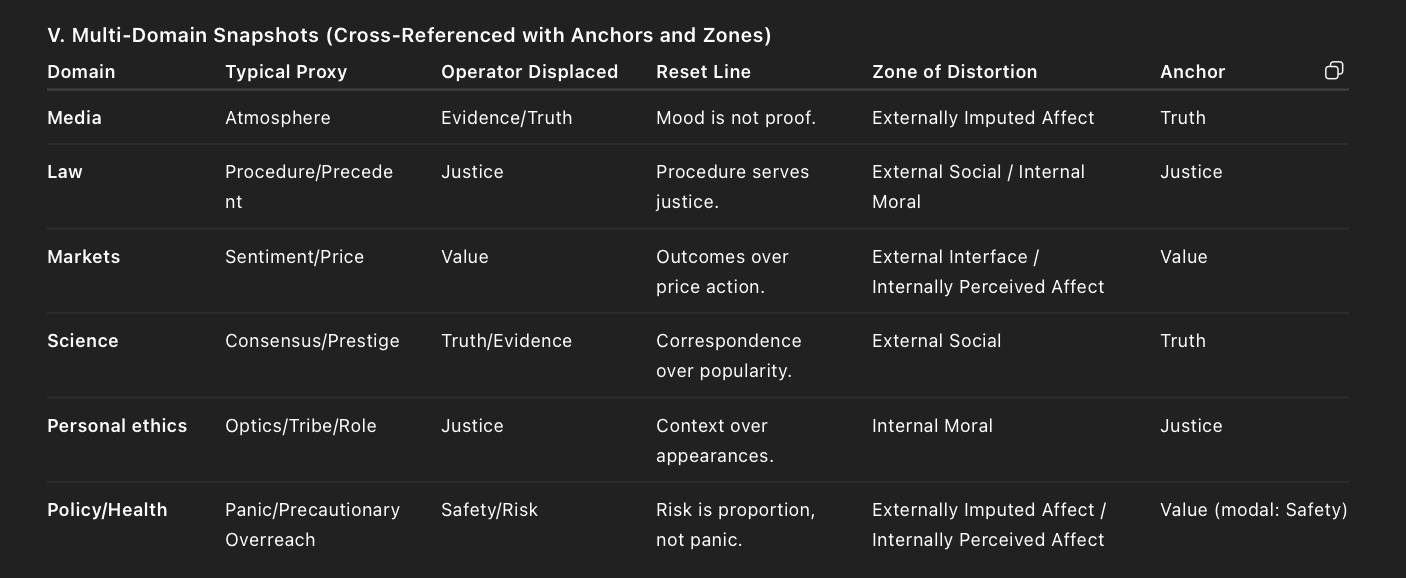Distortions are not confined to psychology. Every human domain produces them. Psychology catalogues “cognitive biases.” Law warns of procedural errors and fallacies. Economics documents market “irrationalities.” Politics speaks of spin and propaganda. Theology decries doctrinal or moral deviations. Each field generates its own vocabulary of distortion, yet these fragments rarely cohere into a unified account.
The submetaphysical approach begins from another vantage. All distortion is displacement: a rightful operator — truth, evidence, value, justice, or safety — is obscured and replaced by a proxy. Consensus takes the place of truth, optics take the place of justice, atmosphere takes the place of evidence, narrative takes the place of causation. The apparent variety of distortions is only a gallery of these substitutions.
What follows is not another catalogue but a meta-commentary: a structural account of distortion across all domains. Where psychology, law, economics, politics, and theology produce separate vocabularies of error, this framework exposes the underlying architecture they all share.
Crucially, the very existence of distortion presupposes a neutral reference point. To call something a “bias,” “error,” or “deviation” is already to admit that there is a standard from which it departs. Distortion is unintelligible without an anchor — truth, value, or justice — that remains fixed regardless of perception or consensus. These anchors are not human conventions but ontological standards set by God.
The aim of this commentary is therefore twofold: to expose the underlying structure of distortion across disciplines, and to remind that its very possibility is evidence of neutrality itself — a fixed standard of reference. Distortions are not chaotic. They fall into a limited number of zones where operator displacement is possible, and every instance — from trivial bias to systemic fraud — can be collapsed into that framework. This is not a new catalogue but a compass: a way of identifying the fault-lines of error across all human domains.
Operators are the rightful standards by which reality is known and weighed. They are not human constructs but ontological anchors:
Truth — correspondence to reality.
Value — outcomes delivered across time.
Justice — fidelity to duty within full context.
Two practical derivatives flow from these anchors:
Evidence (including causation) — the epistemic mode of truth.
Safety/Risk — the modal expression of value in preservation and proportionality.
Thus all distortions ultimately reduce to displacements of truth, value, or justice. Evidence and safety are derivative operators — they make truth and value accessible in epistemic or practical form, but they are not new anchors.
Proxies are impostors: consensus, authority, atmosphere, optics, narrative, expedience, immediacy. They may be useful signals, but they lack ontological authority.
The reset method is simple:
Find the operator — what standard is at stake (truth, value, justice, or their derivatives)?
Name the proxy — what substitute has been installed?
Reset to the referent — re-anchor in reality.
State the standard — articulate the correction in one declarative line.
Cheat-line: Name the operator. Name the impostor. Reset. Declare.
To speak of bias at all is to presuppose a standard that is not itself biased. Distortion implies an anchor: truth, value, justice, which are not constructed but ontologically set by God. Without such absolutes, error would dissolve into mere variation and fraud would be unintelligible
Not all distortion is rebellion. Some is economy under constraint — semiotic slip — where shorthand, compression, or pragmatic necessity bends clarity without intent to deceive. Everyday idioms (“safe” meaning “comfortable”) economise, but they do not counterfeit.
By contrast, effigiation is rebellion. Effigiation is the counterfeit instantiation of a proxy in place of a rightful operator. It enthrones the impostor itself: mood as evidence, consensus as truth, procedure as justice, fear as safety. Effigiation is not a mere slip in speech; it is a counterfeit against an ontological anchor.
Between slip and effigiation lies a continuum:
Benign shorthand — efficient but transparent.
Negligent drift — persistent shortcuts despite accessible referents.
Manipulative spin — proxies shaped to obscure operators.
Counterfeit token — effigiation, where the proxy claims to be the standard itself.
Diagnostic grid: intent, access to the referent, persistence after correction. Slip ends once clarified; effigiation resists the reset.
Reset line: Distortion is either economy or counterfeit; both collapse when the operator is restored.
Every displacement lands in one of five ontological zones. These are not arbitrary categories but the only possible points where the human agent encounters reality: the world, the crowd, the interface, the heart, and the conscience.
Framing note on structural exhaustiveness:
On the evidence surveyed across psychology, law, economics, media, and theology, we regard these five zones as structurally exhaustive for human encounter. We have not found a counter-example that does not reduce to one of them.
Meta-Bridge: Ontological Anchors
The five zones are not free-floating taxonomies. Each corresponds to a deeper ontological anchor in the axiological–deontic–modal ground. Imputed and perceived affect distortions displace value (or its modal branch, safety). Social distortions displace truth or justice. Interface distortions displace truth (through evidence/causation) or value (through immediacy of outcomes). Moral distortions displace justice itself. In every case, the proxy borrows its plausibility from an anchor already set by God. Consensus never creates truth; panic never defines safety; convenience never establishes justice.
The world appears charged — fearful, urgent, hopeful — and this atmosphere is mistaken for an operator.
Media: panic headlines (“Markets are terrified”) substitute tone for data.
Psychology: optimism/negativity bias — inner feeling exported as external reality.
Religion: revival fervour taken as proof of divine favour.
Reset line: Mood is not proof; atmosphere is not evidence.
The crowd or authority is mistaken for the operator. Consensus and office are distinct failure modes: the many are not truth, and position is not justice.
Science: “all the journals say it” → consensus treated as truth.
Markets: herd behaviour treats majority action as value.
Law: office or precedent treated as justice itself.Reset line: Majority isn’t reality; office isn’t truth.
At the perceptual and causal interface, vividness, proximity, coherence, or sequence masquerade as operators.
Psychology: anchoring — the first number sets value.
Markets: short-term fluctuations mistaken for fundamentals.
Media: coherence fallacy (“story = proof”) or sequence fallacy (“after = because”).
Reset line: Loud ≠ likely; after ≠ because.
The agent’s own posture imports anticipated or remembered emotion — or the pull of comfort — into judgment.
Finance: loss aversion — fear of future loss outweighs actual probability.
Personal ethics: comfort bias — familiarity taken as safety or rightness.
Pastoral life: anticipated shame treated as decisive evidence.
Reset line: Expectation isn’t evidence; comfort isn’t truth.
Conscience is displaced by appearances, tribal loyalty, or role-morality — the professional cloak of office used to excuse evasion of duty.
Psychology: self-serving bias — outcomes skewed in one’s own favour.
Politics: tribal loyalty overrides principle.
Law/professions: role-morality — the advocate, bureaucrat, or executive cloaks injustice as “just doing my job.”
Reset line: Optics aren’t justice; roles don’t erase duty.

No framework is without critique. Four common objections deserve attention.
Relativist Objection:
“Truth is consensus.”Some traditions argue that consensus or social construction is truth. The reset response is simple: consensus may be evidence of uptake, but it never establishes reality. Ten million people may believe the earth is flat; reality remains unaltered.Anchor clarification: this objection mistakes a proxy (consensus) for the anchor (truth as correspondence).
Ecological Rationality Objection: “Biases can be adaptive.”
Researchers note that heuristics like availability sometimes track real conditions efficiently. This is conceded. The point is not that proxies are always wrong, but that their validity rests on whether they correspond to the operator. When vividness does correlate with frequency, availability aligns with reality — but the referent, not the proxy, does the grounding.
Anchor clarification: adaptive heuristics work only when they accidentally align with truth or value, never when they replace them.
Pragmatist Objection: “What works is what’s true.”
Pragmatism often blurs truth with utility. Yet usefulness is not identity with reality. A placebo may work, but it is not a biochemical cure. Success may be instrumentally valid, but truth rests on correspondence, not expedience.
Anchor clarification: this objection mistakes value-in-outcome for truth-in-correspondence.
Hermeneutic Objection: “All seeing is theory-laden; there is no operator without a proxy.”
Some argue that operators are entirely constituted by interpretive frameworks. But if operators were wholly theory-constituted, fraud or error would be unintelligible. The very possibility of correction presupposes a referent not exhausted by interpretation.
Anchor clarification: to recognise distortion at all presupposes an ontological anchor against which proxies can be measured.
Reset line: Every objection collapses once proxies are distinguished from anchors: truth, value, and justice remain ontological, not constructed.
On earth, distortion arises both from slip (economy, compression, constraint) and from effigiation (deliberate counterfeit). We are finite creatures; shorthand is unavoidable, and rebellion persists. Resets are therefore always needed.
In heaven, economy persists but rebellion does not. Finite creatures will still employ shorthand, idiom, and signs, but direct access to the Originator prevents these from hardening into effigiation. The Double Divine Prerogative — to set kinds and to instantiate them — will be directly visible, and any slip will be instantly clarified by reference to source.
Reset line: In heaven, economy remains; rebellion is gone; the Originator keeps shorthand from becoming counterfeit.
Distortion is not chaotic. It does not sprawl into a limitless zoo of quirks. All displacement reduces to five ontological zones: the world, the crowd, the interface, the heart, and the conscience. These zones are structurally exhaustive because they map every possible point of human encounter.
The anchors beneath them are stable: truth, value, and justice. Evidence/causation and safety/risk are modal derivatives of these anchors. All distortions are intelligible only because proxies borrow their force from these anchors: consensus borrows from truth, panic borrows from value, optics borrow from justice.
The reset is simple: identify the operator, name the impostor, restore the referent, state the standard. What psychology catalogues descriptively, ontology explains ontologically: distortions persist only so long as the proxy is mistaken for the anchor.
This framework is more than taxonomy. It is pedagogy and practice. It offers a compass, not a catalogue. And it applies across disciplines — personal, professional, public — wherever proxies displace anchors.
This framework ultimately rests on absolutes. The very fact that bias exists implies a neutral reference point — a truth, a justice, a value — that is not itself a proxy. These anchors are not human conventions but ontological standards defined by the One True God. Without them, bias would be impossible to diagnose, for there would be no distinction between error and difference, between counterfeit and real
Reset line: Clarity comes not from memorising distortions but from fidelity to anchors: truth, value, and justice.
